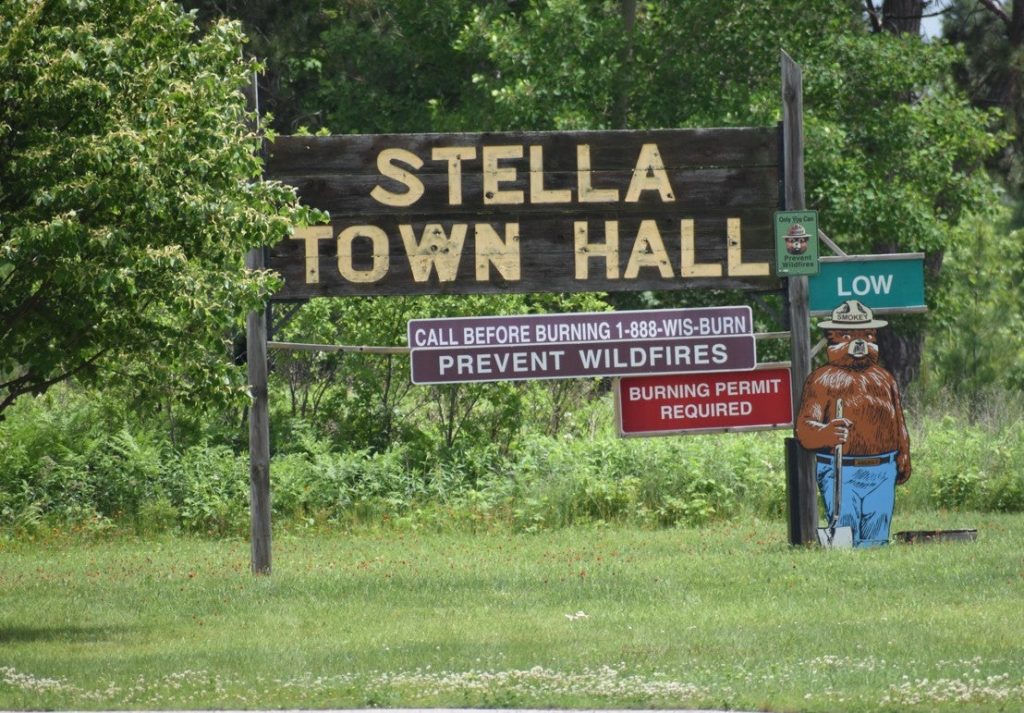DNR Names Companies Responsible for PFAS Contamination In Northern Wisconsin Community
A site inspection found PFAS levels more than three times those typically seen in soil, groundwater and sediments.

The town of Stella in Oneida County has been facing PFAS contamination of private wells and the Moen Lake Chain. A sign for the town hall is pictured here on June 21, 2025. Danielle Kaeding/WPR
The current and former owners of a Rhinelander paper mill are responsible for widespread PFAS contamination in the northern Wisconsin town of Stella, state environmental regulators said in new letters obtained by WPR.
The letters come after a site inspection of the area to evaluate its potential listing as a Superfund site. The Wisconsin Department of Natural Resources conducted the inspection on behalf of the Environmental Protection Agency within Stella and the community of Starks in Oneida County, roughly 9 miles east of the city of Rhinelander. A Sept. 15 site inspection report found “a release of PFAS to soil” within a 3-mile radius of Starks, with the greatest impacts around Starks and an area east of Snowden Lake.
The report states municipal and industrial facilities along with septic companies have spread waste on farm fields in Stella since at least 1996, including treated sewage sludge, paper mill sludge and septage. Sludge from municipal and industrial treatment plants have been known to contain the chemicals due to their use in a wide variety of products.
On Friday, the DNR sent what are known as “responsible party” letters to the Rhinelander mill’s current owner Ahlstrom Rhinelander LLC and Ahlstrom NA Specialty Solutions LLC. The DNR also named the mill’s former owner Wausau Paper Corp., Wausau Paper Mills LLC and Essity North America as responsible parties.
“Those who use PFAS in those processes are the entities that are the root cause of this,” said Christine Sieger, director of the DNR’s Bureau of Remediation and Redevelopment. “It’s the department’s position that those are the entities that we’d like to work with to address the situation.”
Letters say soil sample results collected from areas where industrial sludge were spread contained PFAS at levels “orders of magnitude greater” than soil samples from areas where the agency had no record of spreading the material.
Tricia Schwartz, an Ahlstrom spokesperson, said the company has received the DNR’s letter.
“We are carefully reviewing it along with the recently completed site inspection report,” Schwartz said in a statement. “We continue to actively engage as a partner with WDNR, the U.S. Environmental Protection Agency and other agencies.”
Ahlstrom has said it hasn’t used the chemicals in its manufacturing process since it acquired the mill in 2018. Attorneys for Wausau Paper and representatives with Essity North America did not respond to a request for comment.
PFAS levels found more than 3 times those typically seen in the area
During the inspection, the DNR collected 60 samples from soil, sediment, surface water, groundwater and private drinking water wells. The EPA said the inspection found soil, groundwater, surface water and sediments have PFAS levels significantly beyond concentrations typically found in the area.
The DNR obtained 12 soil samples from seven sites that included the uncontaminated Spur Lake Natural Area and a farm field with no record of spreading biosolids. Testing found only one PFAS compound in a sample from uncontaminated areas. Elsewhere, PFOA and PFOS levels in soil were as high as 63,200 parts per trillion and 218,000 parts per trillion, respectively.
The report also found the chemical NEtFOSAA, which can break down into PFOS, at levels up to 2.3 million parts per trillion in soil samples taken from farm fields.
In drinking water, testing of 22 wells found no PFAS in samples collected from two wells in uncontaminated areas near Stella Lake that are upstream of biosolids spreading. However, testing detected PFAS contamination for 19 of the remaining 20 wells. Samples showed levels of PFOA as high as 29,400 parts per trillion.
That’s thousands of times higher than federal drinking water standards for PFAS of 4 parts per trillion. However, no standards exist for the chemicals in groundwater.
The report states that an estimated population of 686 people in 310 households live within 4 miles of the site.
“All the population relies on groundwater for their potable water,” it says.
Even so, the report notes the number of individuals who are potentially exposed to contamination may be much greater because spreading of biosolids occurred over a large area surrounding Starks.
The DNR has previously found contaminated wells in Stella have some of the highest PFAS levels in the country. More than one third of 241 private wells tested have PFAS levels greater than the state’s recommended health guidelines. Mimi Johnson, director of the DNR’s Office of Emerging Contaminants, said the agency has redirected its limited resources to provide temporary safe water to residents.
“With additional dedicated resources we could continue to provide residents the opportunity to disrupt their exposure through that temporary water, through technical support and funding of new well construction or existing well repairs, (and) installation of treatment systems,” Johnson said.
Gov. Tony Evers and the Republican-controlled Legislature set aside $125 million under the last two-year budget to address PFAS. However, the funds have yet to be released despite repeated requests from Evers. GOP lawmakers have voiced concerned that the money would be used as a “DNR slush fund.”
The DNR acknowledged attempts by GOP lawmakers to provide exemptions under the law to protect certain individuals and facilities from paying to clean up contamination they didn’t cause. Sieger said it’s important that the agency be able to hold PFAS manufacturers and those who use the chemicals responsible.
She added that the agency has not and will not name any residents or farmers responsible for contamination stemming from the spread of sludge on fields. The EPA said it’s too early in the Superfund process too determine the full extent of contamination, including risks posed by PFAS to crops and livestock.
Testing also found high levels of the chemicals in samples from sediments and surface waters, including Starks Creek and lakes on the Moen Lake Chain. However, surface water levels didn’t exceed the EPA’s environmental benchmark levels for PFOA and PFOS. As previously reported, fish tissue sampled from the Moen Lake Chain also found unsafe levels of the chemicals.
The EPA will now continue an expanded site investigation to determine whether the area should be added to the National Priorities List, which prioritizes the most serious contaminated sites for Superfund cleanup funding. Most sites aren’t eligible for cleanup under the Superfund program and the process for listing can take years.
The DNR will join EPA and the Wisconsin Department of Health Services for a public meeting on PFAS contamination of soil and drinking water at 5:30 p.m. Wednesday at the Stella Town Hall.
DNR names paper companies responsible for PFAS contamination in a Wisconsin county was originally published by Wisconsin Public Radio.
If you think stories like this are important, become a member of Urban Milwaukee and help support real, independent journalism. Plus you get some cool added benefits.
More about the PFAS Problem
- Wisconsin Communities Get $282 Million for Drinking Water Projects - Danielle Kaeding - Nov 19th, 2025
- Gov. Evers, DNR Announce $282 Million to Improve Drinking Water Quality for Wisconsinites in 74 Municipalities - Gov. Tony Evers - Nov 18th, 2025
- Cleanup of PFAS Could Cost Wisconsin Billions - Danielle Kaeding - Nov 13th, 2025
- Cleanup PFAS Without Penalizing Innocent Landowners - Wisconsin Manufacturers & Commerce - Nov 4th, 2025
- Wisconsin Lawmakers, DNR Clash Over PFAS Protections in GOP Bills - Danielle Kaeding - Oct 8th, 2025
- Wisconsin Moves to Bring PFAS Limits In Line with Contested Federal Standards - Danielle Kaeding - Oct 3rd, 2025
- DNR Names Companies Responsible for PFAS Contamination In Northern Wisconsin Community - Danielle Kaeding - Sep 30th, 2025
- Green Bay Area Ducks Contaminated with ‘Forever Chemicals’ - Isiah Holmes - Sep 8th, 2025
- DNR and DHS Issue New PFAS-based Consumption Advisory for Ducks Harvested on Green Bay - Wisconsin Department of Natural Resources - Sep 4th, 2025
- DNR and DHS Issue New PFAS-based Consumption Advisories for Fish and Deer Near town of Stella and Surrounding Waterbodies in Oneida County - Wisconsin Department of Natural Resources - Sep 4th, 2025
Read more about PFAS Problem here






















I wonder what kinds of farming is happening on this land where the poisons are spread?
Current owners are responsible for any contamination caused by their predecessors in title by sale, merger, or otherwise. Due diligence procedures should not protect them from liability.